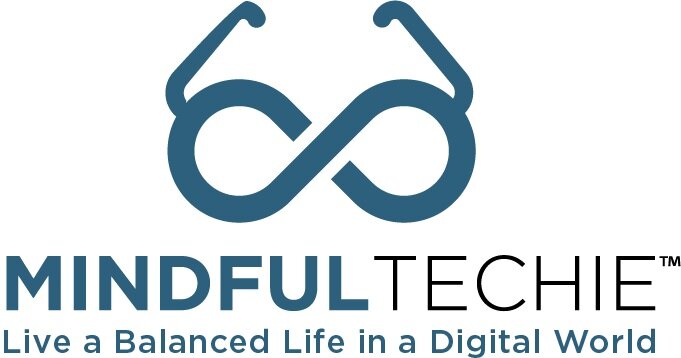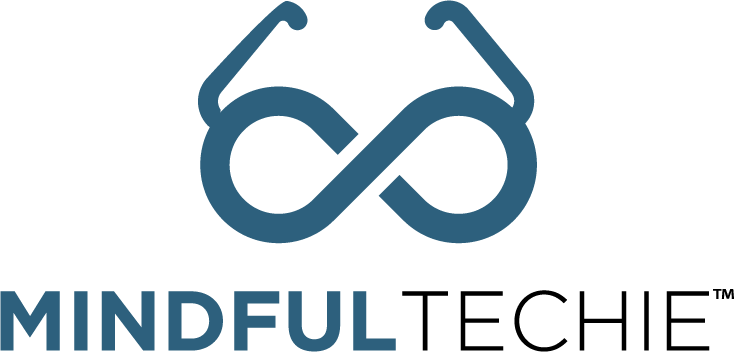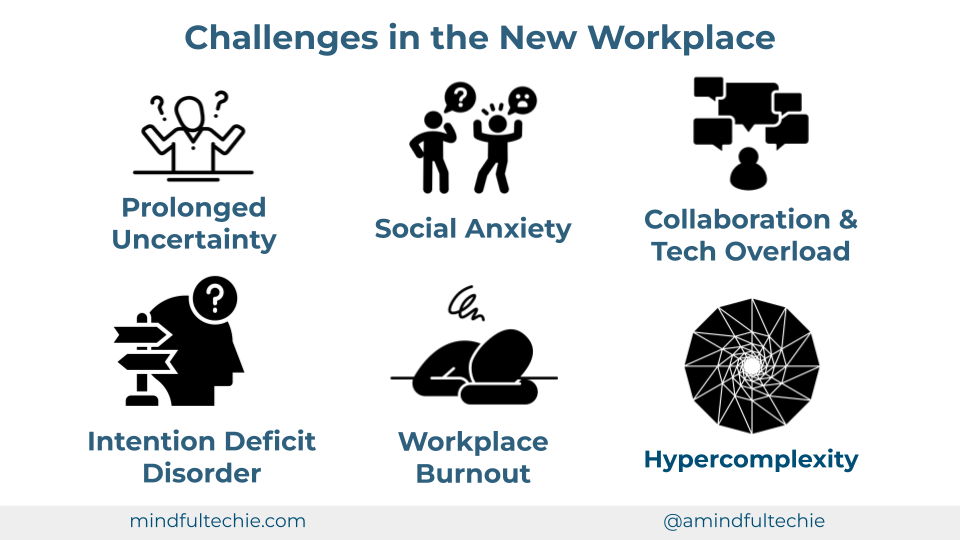The way we're working isn't working
I get it. You’re committed to making a positive difference in the world. You love what you do and you’re good at it. But you struggle with finding the right balance between work and having a fulfilling personal life. Maybe you believe balance is a myth or a luxury that’s out of reach for someone like you. And as the world becomes more complex, it may seem change, disruption, and uncertainty have become a new norm in your life and work.
I know many days, from the moment you wake up, you’re bombarded with distractions—emails, texts, social media notifications, and your mental checklists. And given the realities of today’s 24/7 world, you’re grappling with how to keep up, make a meaningful impact, and live a fulfilling life with so many things competing for your limited time, attention, and energy.
I know because I used to be like you, and I’ve helped countless professionals like you improve their well-being so they could have a more sustainable impact in changing the world. During my previous career, I was often on the edge of burnout doing my part to fulfill my organization’s vision of a world free of HIV and hepatitis.
At my lowest point, I was severely depressed, the heaviest I’d ever been in my life, and feeling like a failure even though I was burning the candle at both ends. I was doing the work of an entire department while trying to build a team and steer a clear course for my organization. There were days I didn’t feel like getting out of bed. And there were more days I simply couldn’t get out of bed because my body wouldn’t let me.
No matter how long, hard, or smart you work, the work doesn't stop.
I realized that even if I worked myself to death, the work wouldn’t stop. The emails would keep rolling in, and the projects would keep moving ahead—this time without me.
Unfortunately, stories like mine are common among changemakers. According to the WellBeing Project, a global non-profit organization focused on catalyzing a culture of inner well-being for all changemakers, research shows we experience high levels of burnout, stress, depression, chronic illness, and weak personal and professional relationships, all in the name of making the world a better place.
We also experience high levels of “moral distress” or guilt, sadness, and defeat as we are constantly reminded of our limited time, resources, and abilities relative to the enormity of the challenges we’re trying to solve.
But it doesn’t have to be this way. I nearly came face-to-face with a life-threatening health crisis to realize this. I was fortunate because my low point was the beginning of a beautiful journey that led me to dedicate my time to helping changemakers like you do great work even better while taking good care of yourself along the way.
However, the world has changed. We’re living in a time where change is rapid, exponential, and unrelenting. As the pace of life speeds ups and advances like artificial intelligence or hybrid work becomes the norm, you may be struggling to keep up or make sense of things. Or maybe you’re grieving the loss of an “old way” of doing things that will never return. In my work with changemakers on creating a culture of lasting well-being in the social sector, I’ve observed how today’s rapidly changing world has contributed to or exacerbated the following challenges:
Prolonged Uncertainty: The past few years have created prolonged uncertainty and disruption, which make planning challenging. We thrive with routines and having a sense of control over our life and work. An absence of predictable routines and personal control negatively impacts our mental health. Thriving in today’s changing world requires us to learn how to get grounded in what seems like a groundless world.
Social Anxiety: Now that we’re in a post-pandemic world, connecting via a mix of remote and in-person interaction is the norm. For some, the pandemic is a thing of the past. But for the others, there’s a lingering residue that created anxiety and uneasiness about norms such as hugs and handshakes. And we’re navigating evolving etiquette such as when cameras should be on or off during hybrid or remote meetings and different preferences for remote vs. in-person work.
Workplace Burnout: Mental, emotional, and physical exhaustion from chronic work-related stress and overwhelm have skyrocketed in recent years. This exhaustion can stem from having unclear goals, unmanageable workloads, unreasonable time pressures, limited resources and support, lack of flexibility, and interpersonal conflicts. Boundaries between work, life, and even the days of the week and time of day can sometimes seem blurred beyond recognition. And it’s become increasingly harder to manage expectations around availability, especially in hybrid workplaces.
Collaboration and Technology Overload: The onslaught of using video conference platforms and other digital tools for everything from work meetings to family holiday celebrations has resulted in overload, burnout, and screen exhaustion.
Hypercomplexity: We live in a fast-changing world and there are no signs things are slowing down anytime soon. As soon as you learn the latest technology, a new one is already being rolled out. Economies and political systems are experiencing more rapid shifts. And what is work and how we work are moving targets.
Intention Deficit Disorder (IDD): Many of us are so overloaded that we move through our days on autopilot, allowing life to happen to us instead of for us. This is a symptom of what I call intention deficit disorder (IDD). It's a disorder I frequently see with the clients I help who are going through the motions of life without knowing why. The hallmark signs are: 1) consistently living on autopilot and out of alignment with your core values; 2) taking action without meaning or purpose; 3) being busy without a clear intention in mind. We end up being exhausted from non-stop busyness but may question whether we’re really moving the needle on the things that really matter.
All these factors have converged into what Nicola Brown, founder of the Kokoro Wellness community and platform, calls “swirling.” This is where, despite things seeming to return to “normal” after the pandemic, we still carry the residue of unresolved trauma from previous change and disruption. But to keep things moving, we engage in mental and emotional masking, put on a brave face, and return to the world.
The result is a swirl of things we’re experiencing intermittently and simultaneously as we try to move forward. It’s like driving with the parking brake on or feeling like you’re treading water.
Some ways this might show up for you might be:
Uncertainty about whether the pandemic is still happening or not…because it really depends on who you ask.
Being anxious about external pressures like inflation, job market changes, charitable giving fluctuations, etc.
Constantly feeling caught off guard or playing catch up with disruptions like artificial intelligence, the emergence of new social media platforms, etc.
Feeling like you’re unable to get closure as you grieve the loss of loved ones, the “old” way of doing things, or the loss of stability/predictability…and that you’re being rushed to move on.
But you are not alone. And the challenges you are experiencing aren’t your imagination or your fault.
You are not deficient for feeling persistently overwhelmed and overworked. We’re all doing the best we can with what we have with the systems we have inherited. And that’s all we can ask or expect of ourselves.
Over the course of our waking adult lives, we spend one-third of our time working. This doesn’t even include commuting to work, thinking about work, or worrying about work. Because of the huge role it plays in our life, work greatly impacts our overall well-being.
The truth is we have inherited a way of working that hasn’t worked for a very long time. And there are organizational and societal issues we must confront head-on if we’re serious about long-term solutions for everyone. We must reimagine systems that perpetuate the need to be “resilient” as a prerequisite for thriving. For example, the 40-hour workweek wasn’t designed for single people or households with two working partners. This model for the workweek is a relic of the early 20th century that depends on one partner staying home to take on unpaid household labor. In addition, historically, social sector organizations have been underfunded, under-resourced, and consistently forced to do more with less.
What we need are people-first organizational cultures that center the well-being of employees as well as healthy approaches to getting the work done.
To this end, the U.S. Office of the Surgeon General identifies five essential components of mental health and well-being at work: protection from harm, connection & community, work-life harmony, mattering at work, and opportunity for growth.
Organizations actively engaged in moving the needle in each of these areas see reduced health risks for employees, increased engagement, higher productivity, improved quality of life and happiness levels, greater impact, and lower turnover. When people are thriving at work, they are more likely to be healthy physically, mentally, and emotionally.
Addressing workplace well-being long-term requires addressing the root causes of burnout culture at a systemic level. For change-making professionals, ideally, we would start at the organizational level by holistically designing systems that address the causes of toxic workplace stress and anxiety. This shift would move us away from the artificial separation between work and life, where we stay busy managing a constant deluge of emails, meetings, overflowing calendars, and long lists of commitments for which we’ll never have enough time.
This means that well-being in the workplace isn’t just an individual concern. It’s also the responsibility of the organizations we serve. This responsibility requires us to recognize we can recover from and prevent burnout, but only when we intentionally approach well-being at all levels of our organization.
While you may not be in a position to influence long-term changes in your organization’s culture as one individual, you can focus attention on the things you can control at the individual and team levels while pushing for organizational change over the long term.
If you’ve ever flown on an airplane, you’ve probably heard this safety instruction many times: “In the event of a sudden drop in pressure, an oxygen mask will drop from above. Secure your own mask first before assisting others.” For many of us, our quest for greater well-being, while we save the world, means starting with ourselves.
That’s why I’m on a mission to support you in balancing your well-being, work, life, and modern life’s distractions so you can focus more on mission-critical activities. I focus on tactics for holistically addressing the inner work (mental and emotional labor—connection to purpose, mindset, thoughts, emotions) and outer work (”physical” labor—time, people, and project management). I believe if we don’t address the inner mental and emotional roadblocks that get in the way of putting ourselves at the top of our to-do lists, none of the strategies we learn from books, blog posts, professional development training, or other resources will matter.
My work inside change-making organizations focuses on practices and strategies connected to the Well-Being While Well-Doing C.H.A.N.G.E.™ framework outlined below.
C - Connect to your WHY: Here you focus on clarifying and (re-)connecting to what inspires you to do change-making work.
H - Honor your priorities: This pillar supports you in honoring what’s truly important and urgent.
A - Acknowledge your fears & limiting beliefs: Here you confront imposter syndrome and other limiting beliefs head-on with grace and compassion.
N - Negotiate boundaries: This pillar emphasizes strategies for creating and protecting boundaries needed to honor your priorities.
G – Generate space to go within: This pillar focuses on how to manage distractions and put rest, reflection, and restoration into your schedule with intentionality.
E - Embody well-being while well-doing: Here you focus on integrating all the previous pillars and putting in place support for sustained transformation.
This isn’t a linear or sequential process. Instead, these are six pillars we operate in simultaneously. You can think of them like the dashboard of a car which has gauges for different functions, but all of them are important for optimal performance. So, in this analogy, you are the car, and each letter in C.H.A.N.G.E.™ is a gauge representing a different aspect of your well-being. Collectively, these pillars are the starting point for creating and sustaining well-being while doing great work over the long term.
But you don’t have to figure it all out on your own. I invite you to consider what type of support, accountability, coaching, and community you need for your journey.
This is one of the reasons I created the Virtual Wellness Retreat for Changemakers. It’s a 2-day experience where we dive into the inner and outer work of increasing your well-being while well-doing for the long haul. Are you looking for a deeper dive into how to create a permanent culture of well-being for you and your team? Join us at our next retreat. Learn more at mindfultechie.com/retreat.
P.S. If you are enrolling 6 or more team members in the upcoming retreat, email meico@mindfultechie.com for special pricing details and instructions on how to book your complimentary post-retreat strategy session. During our call, we’ll strategize ways to make the strategies covered during the retreat part of your team and organization’s culture.







